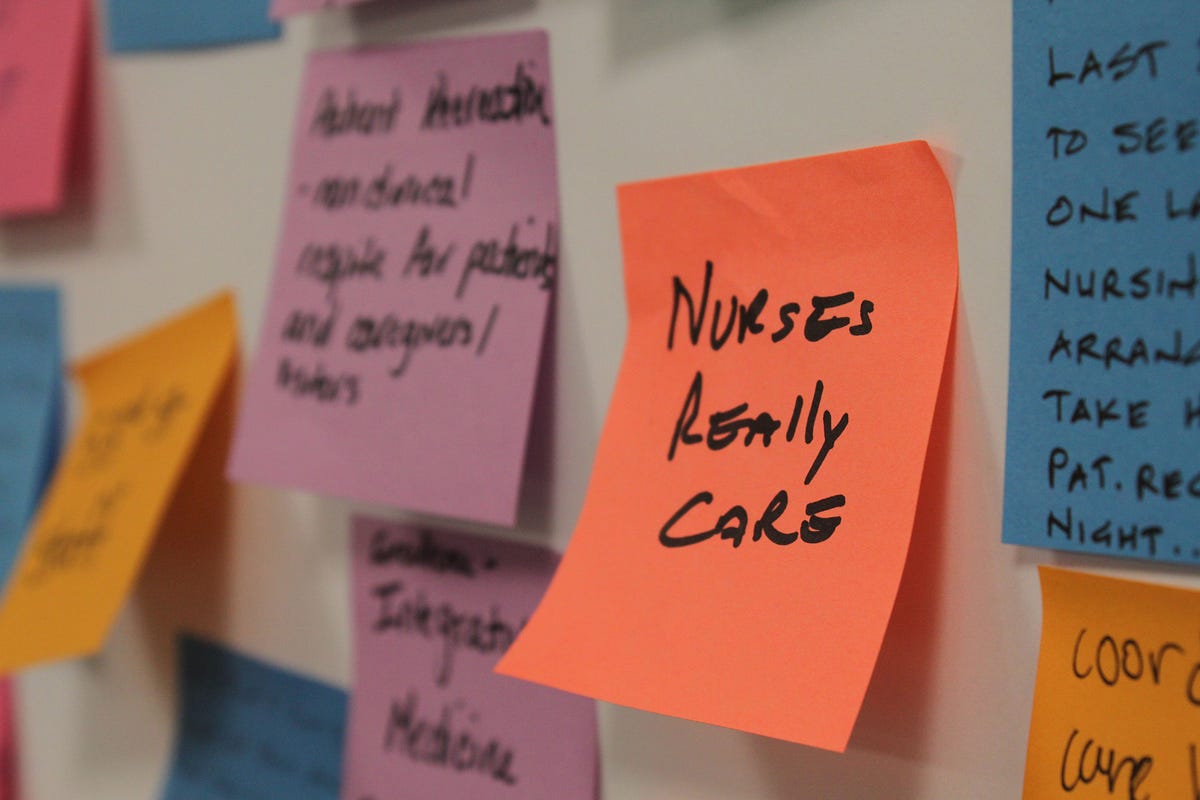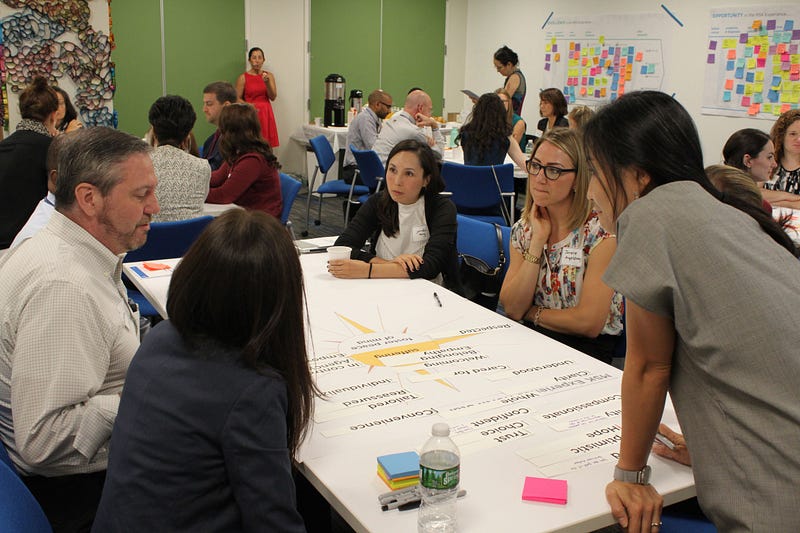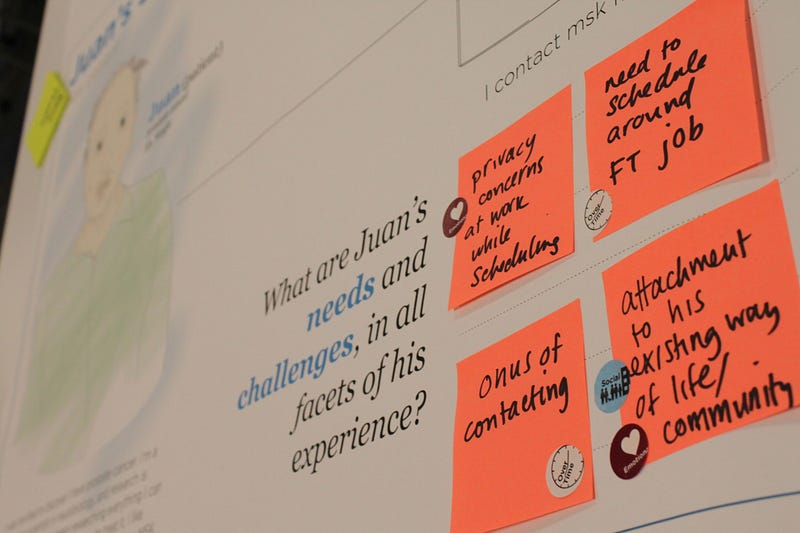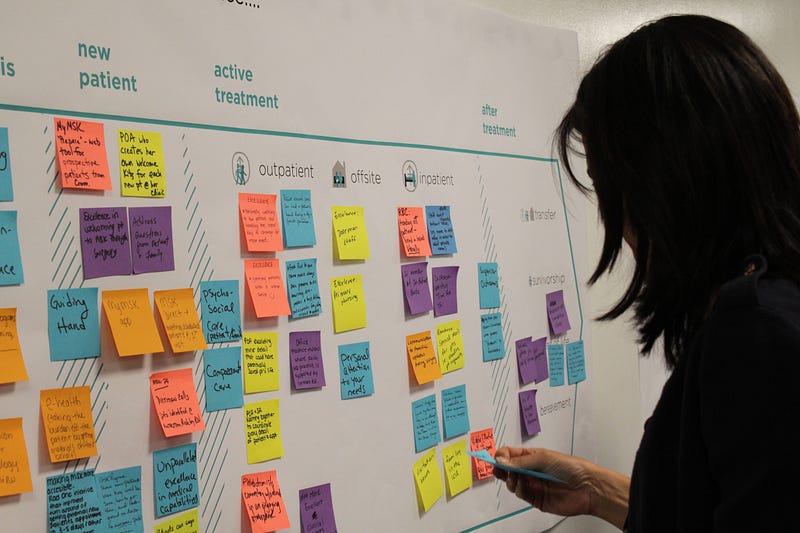Design Thinking + Cancer

When we think about design sprints, design thinking, and innovation, cancer probably isn’t often the first topic that comes to mind.
Yet some of the most fascinating research and brilliant minds are showing great success in harnessing designing thinking to shape the experiences around cancer care. Patty Beirne is one of them.
Patty is the Creative Lead within Design & Innovation of Memorial Sloan Kettering Cancer Center in NYC. She illuminated one of our recent DT/DS panels, where she contributed her stories regarding innovation within healthcare.
Talking design thinking and innovation with Patty
Jay: How do you use design thinking at Memorial Sloan Kettering to shape the experience of cancer care?
Patty: Cancer care is uniquely complex. It is a challenge to coordinate efforts from so many stakeholders with different roles and perspectives — patients, multiple physicians, nurses, administrators, clinical researchers, insurers, family members, social workers, financial advisors…(the list goes on and on). But also, this is a type of care that upends and forever changes one’s life — on a physical, emotional, social and financial level.
The stakes are high in so many ways for our patients and for the staff who are serving them. Even the smallest gesture in a system like this can make a fairly profound impact on one of those very human dimensions of experience. Design thinking helps us better understand what is really going on for each of these participants — what motivates and drives them… how they see their participation in this system. As we do this, we are able to identify opportunities to re-envision what we are doing to move strategically into the future.

Jay: What are the top 2 challenges you’ve faced in your role at Sloan Kettering?
Patty:
#1. Design innovation relies on trans-disciplinary collaborations, yet healthcare is so siloed. We have so much talent and knowledge at our institution, but need to work against the nature of the industry to bring people together to collaborate and think in new ways.
We are lucky that Memorial Sloan Kettering began introducing design thinking almost a decade ago, so it has become slowly integrated into pockets of the organization.
#2. The knee jerk reaction to design concepts is often that they are “nice to have.” At a cancer hospital we cannot justify asking the institution to invest in wild ideas because they seem cool or even desirable at the expense of something they know will move closer to their strategic goals.
“Nice to have” is another way of saying “not this year”. So we need to be very focused on developing concepts and metrics that will convey the strategic import of design interventions. And we need to be ready to test and iterate with an eye to the future.
Jay: Why is design thinking so important to the patients and families at Sloan Kettering?
Patty: MSKCC is a really amazing institution in that everyone really is committed to the patients and their families. Still, the service experience of cancer care can be pretty dehumanizing.
Design Thinking facilitates a human-centered approach to how we understand the patient and family experience and allows us to shape experiences that alleviate anxiety and restore dignity in as many interactions as possible.
Dignity is important to patients. And design is a good way to understand and deliver that otherwise intangible quality of care.

Jay: What are some upcoming projects that you’re super excited about?
Patty: Our team has been doing a lot of work around how we can best serve our patients in the time that patients are not in our facilities — the interstitial gaps of time between treatments or follow ups.
We are gearing up to run more design sprints around these challenging moments before, during, and after care. The exciting part is prior to the sprints, when we find out what the true needs and challenges are. This is a space we have a lot of educated guesses about — but the experience is so different for patients and families when they are untethered from their care team — before someone’s first appointment, between appointments during treatment, or after they reach survivor status. We are excited to see what we can achieve by crafting the experience in these otherwise unseen moments.
Jay: What advice would you give to other design and innovation leads that are trying to bring design thinking and innovation practices into their organizations?
Patty: Bring people together who don’t usually collaborate and use design sprints to facilitate their thinking around a shared challenge. Design thinking can help people see how to reframe problems and leverage each other toward a shared goal in ways they never could have if they were in it alone.
Inspiring collaboration among colleagues can really convey the value of design to newcomers and validate the potential of design to those who champion innovation in their institutions.
Jay: What recommendations would you give to someone looking to enter the design world within healthcare?
Patty: A lot of people think that being a designer in healthcare requires experience in healthcare, and that without it they have nothing to offer. Though knowledge of healthcare is always a plus, I have found that designers who feel comfortable envisioning and shaping human experiences within complex systems — like government, education, economics, etc — have skills that healthcare is hungry for.
Understanding and communicating how people experience various touchpoints in a system and how those are interrelated is an increasingly valuable skill. And it is pretty rare since design has not traditionally taken leadership in systemic problems. That is changing, though, and the need for people who think about experience as it relates to systems is greatly needed.
Having experience designing medical devices may even be less valuable than complex service and/or experience design in other industries. Keep chasing after the complex problems and eventually one of them will touch upon healthcare.

The future of design thinking in healthcare
It’s inspiring to see teams like Patty’s making great use of design thinking and design sprints to solve some of the most critical human needs. So many of forget that these practices have a ton of merit in fields outside of digital.
As we learned from Patty today, there have been plenty of challenges over the past 10 years at MSKCC, and it sounds like there will be many more. Introducing design thinking and design sprints into any organization is mostly about changing mindsets. Couple that with all of the human health and privacy concerns within healthcare, and we can begin to appreciate the phenomenal progress MSKCC has made.
What do you think?
Are you experimenting with design thinking and design sprints within healthcare? Would you like to hear more about the intersection of healthcare and innovation?
We’d love to hear from you! Leave comments in this article. Write a response to this article to share your stories. And let us know if you’d like your experiences to be captured in an upcoming Design Thinking article.


